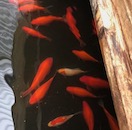by Barbara Faurot
What is a kitchen garden? From ancient traditions in Egypt, Babylon and Mesopotamia, to medieval monasteries and the “keyhole” gardens of Africa, kitchen gardens have served both the culinary and aesthetic needs of their communities. Today, family kitchen gardens are popping up in backyards, carrying on the tradition of growing food for the table in a sustainable manner while adding visual appeal to the landscape.
Instead of straight rows of crops, plantings in a kitchen garden are designed to take advantage of different microclimates and natural features to grow vegetables, fruits, herbs, and flowers as part of a beautiful landscape.
Mary Hunt and Mike Farrell have created a wonderful example of a kitchen garden in Port Townsend. The first thing I noticed when visiting their garden is the spectacular color and diversity: clusters of flowers, native shrubs, ferns, vegetables, fruit trees, herbs, and more. Underlying it all is a spirit of constant experimentation. As Mary says, “We try things, and keep trying things until something loves the place.”
A pole barn-size fenced garden is set into the slope of the backyard. Here, there are individual raised beds and planting areas with herbs, vegetables, loganberries, and edible flowers. Pathways between the beds are easy to access and covered with alder chips for weed suppression. Next door, there’s a greenhouse that looks pretty normal from the outside. But inside, there’s a fish tank, vegetables growing from a bed of gravel, and a pleasant bubbling sound.
 Mary explains that, in her “obsession” with growing organic food in limited space, she learned about aquaponics systems where fish and plants comingle their needs. Mary and Mike put together a system that “provides food year round, even during the limited light of a Pacific Northwest winter.” Inside the greenhouse, their pet goldfish provide fertilizer for the plants, and the system provides oxygen for the fish. Three times a day water is filtered through the gravel and returned to the 300 gallon fish tank, recycling 95 percent of the water.
Mary explains that, in her “obsession” with growing organic food in limited space, she learned about aquaponics systems where fish and plants comingle their needs. Mary and Mike put together a system that “provides food year round, even during the limited light of a Pacific Northwest winter.” Inside the greenhouse, their pet goldfish provide fertilizer for the plants, and the system provides oxygen for the fish. Three times a day water is filtered through the gravel and returned to the 300 gallon fish tank, recycling 95 percent of the water.
Their aquaponics experiment is in its fifth year, producing tomatoes, cucumbers, lettuce, basil, chard, and green bush beans inside a 5’x20’ growing space. In the summer, additional pots in the greenhouse grow peppers which need hotter conditions than the water provides. In winter, the aquaponics system continues to produce a variety of leafy greens. (More information on aquaponics can be found at the USDA’s National Agricultural Library: www.nal.usda.gov/afsic/.)
Uphill from the greenhouse — all created since summer 2019 —are cherry, peach, and pear trees, berries, more herbs, and flowers. Next to the backyard forest is a simple yet beautiful espalier to grow Fuji, Honeycrisp and Gala apples.
 The big lesson learned is that you can do a lot in a small space without pesticides or waste. The principles of the traditional “keyhole” garden still apply today:
The big lesson learned is that you can do a lot in a small space without pesticides or waste. The principles of the traditional “keyhole” garden still apply today:
Experimentation: Keep trying new things, using seeds and plants from a variety of local sources. The WSU Master Gardener Seed Library is a good resource to learn about seed saving and seed sharing: extension.wsu.edu/jefferson/master-gardener-seed-library/.
Sustainability: Improve soil tilth, water usage, and drainage with raised beds and home composting (a central composting basket is found in traditional African kitchen gardens). Create outer walls or fences from local or recycled materials.
Connection: Get inspired by learning from and sharing with neighbors. Mary learns from fellow volunteers with the Quimper Community Harvest Gleaners and the Raincoast Farms Food Bank Garden, just added to the county’s food bank network in March 2020. To help people bring fresh food from a food bank or farmer’s market to their kitchens, she has created a series of “Snapped Up” recipes, focused on local whole plant foods l2020.org/local-food/snapped-up-recipes/.
Mary’s and Mike’s garden is scheduled to be on the 2022 Jefferson County Master Gardener Foundation’s Secret Garden Tour. Mark your calendars for June 18, 2022.
Barbara Faurot is a Jefferson County Master Gardener and Master Pruner, working with other volunteers who serve as community educators in gardening and environmental stewardship.
Published in the Port Townsend Leader June 10, 2020


